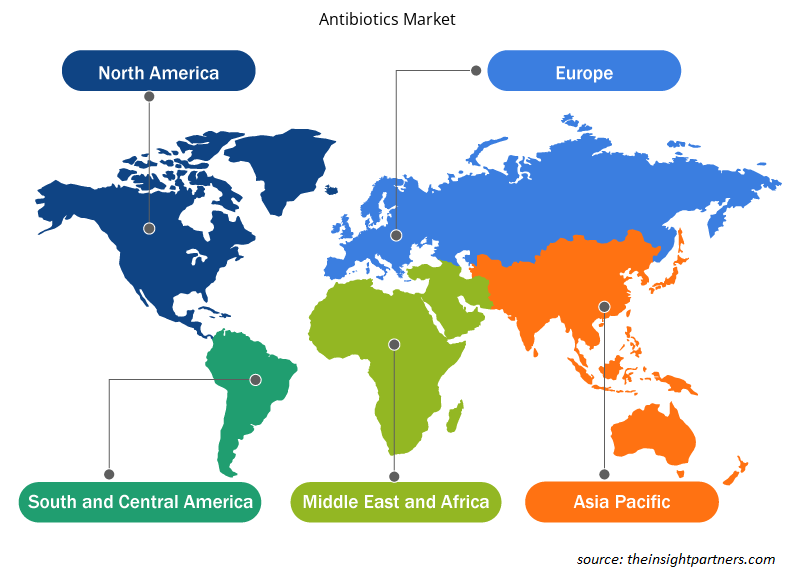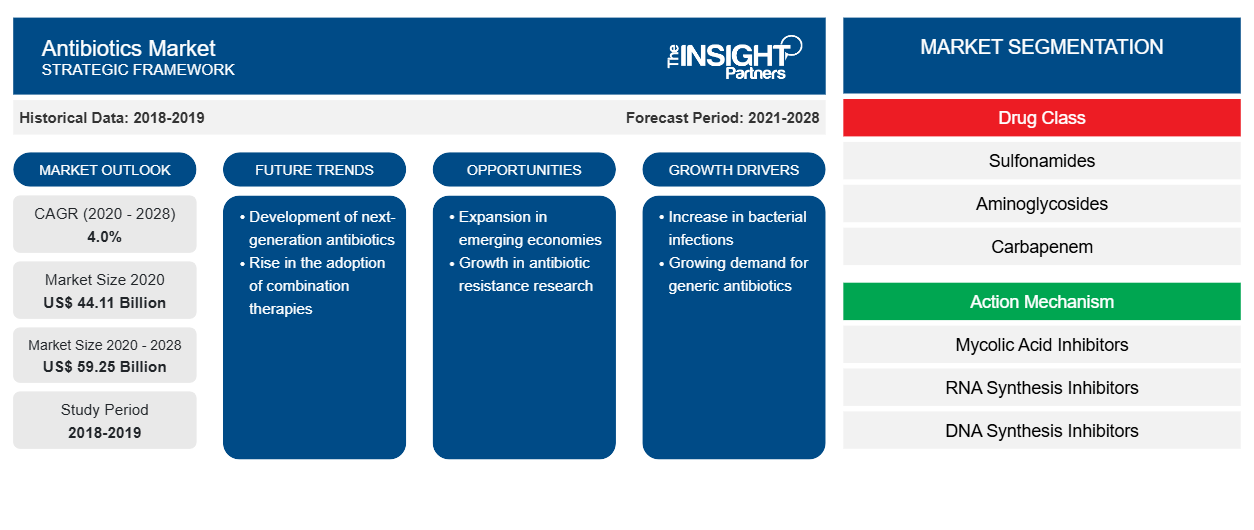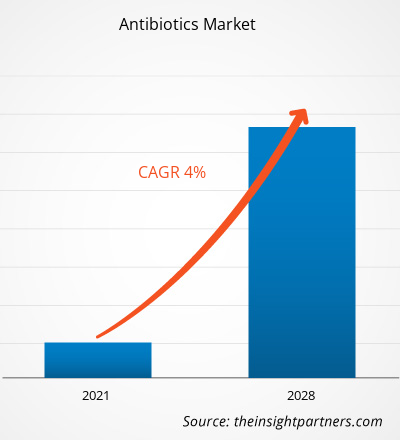El mercado de antibióticos se valoró en US$ 44.111,31 millones en 2020 y se proyecta que alcance los US$ 59.253,24 millones en 2028; se espera que crezca a una CAGR del 4,0% durante 2021-2028.
Los antibióticos son medicamentos potentes que se utilizan para combatir las infecciones y enfermedades bacterianas. Se utilizan específicamente para tratar infecciones causadas por bacterias como estafilococos, estreptococos o E. coli. Los antibióticos matan las bacterias (bactericidas) o impiden que se reproduzcan y crezcan (bacteriostáticos). Los antibióticos que se comercializan no funcionan contra ninguna infección vírica. Algunas de las infecciones más comunes que se tratan con antibióticos son la conjuntivitis, las infecciones de la piel o de los tejidos blandos, las infecciones del tracto respiratorio superior, la bronquitis, la faringitis estreptocócica (faringitis estreptocócica), entre otras.
Perspectivas del mercado
Creciente desarrollo de medicamentos genéricos
Un medicamento genérico es una copia de un medicamento de marca que ya no está bajo patente. Las versiones genéricas se introducen en el mercado con el objetivo de ofrecer medicamentos rentables y aumentar el alcance de estos medicamentos a personas que pertenecen a diferentes clases económicas. Las versiones genéricas son populares debido a su disponibilidad y asequibilidad. Por ejemplo, según un estudio publicado en el NCBI en 2018, el precio promedio de prescripción de marca era casi 4 veces el precio promedio de genéricos. Además, las empresas también se están centrando en el desarrollo de versiones genéricas con el objetivo de ofrecer antibióticos a costos mínimos. Por ejemplo, en junio de 2018, Lupin lanzó una solución de inhalación genérica de tobramicina en el mercado estadounidense. Además, también se proyecta que el estímulo de las autoridades gubernamentales impulse la producción de antibióticos genéricos, lo que eventualmente impulsaría el crecimiento del mercado de antibióticos durante el período de pronóstico. Por ejemplo, en febrero de 2019, la Administración de Alimentos y Medicamentos de los EE. UU. (FDA de EE. UU.) anunció la aprobación para la comercialización de medicamentos genéricos fabricados por compañías farmacéuticas indias en los EE. UU.
Personalice este informe según sus necesidades
Obtendrá personalización en cualquier informe, sin cargo, incluidas partes de este informe o análisis a nivel de país, paquete de datos de Excel, así como también grandes ofertas y descuentos para empresas emergentes y universidades.
- Obtenga las principales tendencias clave del mercado de este informe.Esta muestra GRATUITA incluirá análisis de datos, desde tendencias del mercado hasta estimaciones y pronósticos.
Información sobre el tipo de prueba
Según la clase de fármaco, el mercado de antibióticos se segmenta en sulfonamidas, aminoglucósidos, carbapenémicos, macrólidos, fluoroquinolonas, penicilina, cefalosporinas y otros. El segmento de cefalosporinas tuvo la mayor participación del mercado en 2020; mientras que se prevé que el segmento de fluoroquinolonas registre la CAGR más alta del mercado durante el período de pronóstico.aminoglycosides, carbapenem, macrolides, fluoroquinolones, penicillin, cephalosporin, and others. The cephalosporin segment held the largest share of the market in 2020; whereas the fluoroquinolones segment is anticipated to register the highest CAGR in the market during the forecast period.
Perspectivas sobre el mecanismo de acción
Según el mecanismo de acción, el mercado de antibióticos se ha segmentado en inhibidores de ácido micólico, inhibidores de la síntesis de ARN, inhibidores de la síntesis de ADN, inhibidores de la síntesis de proteínas e inhibidores de la síntesis de la pared celular. El segmento de inhibidores de la síntesis de la pared celular tuvo la mayor participación del mercado en 2020, mientras que se estima que el segmento de inhibidores de la síntesis de ADN registrará la CAGR más alta del mercado durante el período de pronóstico.
Las estrategias de lanzamiento y aprobación de productos son comúnmente adoptadas por las empresas para expandir su presencia y cartera de productos en todo el mundo y satisfacer la creciente demanda.
Los actores del mercado de antibióticos adoptan una estrategia de expansión para ampliar su base de clientes en todo el mundo, lo que también les permite mantener su marca a nivel mundial. Por ejemplo, en julio de 2019, una empresa como Pfizer lanzó un consorcio internacional de investigación para descubrir y desarrollar nuevos antibióticos contra la tuberculosis en colaboración con ocho socios biotecnológicos y académicos europeos.
Perspectivas regionales del mercado de antibióticos
Los analistas de Insight Partners explicaron en detalle las tendencias y los factores regionales que influyen en el mercado de antibióticos durante el período de pronóstico. Esta sección también analiza los segmentos y la geografía del mercado de antibióticos en América del Norte, Europa, Asia Pacífico, Oriente Medio y África, y América del Sur y Central.

- Obtenga datos regionales específicos para el mercado de antibióticos
Alcance del informe sobre el mercado de antibióticos
| Atributo del informe | Detalles |
|---|---|
| Tamaño del mercado en 2020 | US$ 44,11 mil millones |
| Tamaño del mercado en 2028 | US$ 59,25 mil millones |
| Tasa de crecimiento anual compuesta (CAGR) global (2020-2028) | 4.0% |
| Datos históricos | 2018-2019 |
| Período de pronóstico | 2021-2028 |
| Segmentos cubiertos | Por clase de fármaco
|
| Regiones y países cubiertos | América del norte
|
| Líderes del mercado y perfiles de empresas clave |
|
Densidad de actores del mercado: comprensión de su impacto en la dinámica empresarial
El mercado de antibióticos está creciendo rápidamente, impulsado por la creciente demanda de los usuarios finales debido a factores como la evolución de las preferencias de los consumidores, los avances tecnológicos y una mayor conciencia de los beneficios del producto. A medida que aumenta la demanda, las empresas amplían sus ofertas, innovan para satisfacer las necesidades de los consumidores y aprovechan las tendencias emergentes, lo que impulsa aún más el crecimiento del mercado.
La densidad de actores del mercado se refiere a la distribución de las empresas o firmas que operan dentro de un mercado o industria en particular. Indica cuántos competidores (actores del mercado) están presentes en un espacio de mercado determinado en relación con su tamaño o valor total de mercado.
Las principales empresas que operan en el mercado de antibióticos son:
- Pfizer, Inc
- Johnson & Johnson Services, Inc. (productos farmacéuticos Janssen),
- Abad,
- GlaxoSmithKline S.A.,
- Sanofi,
Descargo de responsabilidad : Las empresas enumeradas anteriormente no están clasificadas en ningún orden particular.

- Obtenga una descripción general de los principales actores clave del mercado de antibióticos
Mercado mundial de antibióticos: por clase de fármaco
- Cefalosporina
- Penicilina
- Fluoroquinolonas
- Macrólidos
- Carbapenémico
- Aminoglucósidos
- Sulfonamidas
- Otros
Mercado mundial de antibióticos: por mecanismo de acción
- Inhibidores de la síntesis de la pared celular
- Inhibidores de la síntesis de proteínas
- Inhibidores de la síntesis de ADN
- Inhibidores de la síntesis de ARN
- Inhibidores del ácido micólico
- Otros
Antibióticos a nivel mundial, por geografía
América del norte
- A NOSOTROS
- Canadá
- México
Europa
- Francia
- Alemania
- Italia
- Reino Unido
- España
- Resto de Europa
Asia Pacífico (APAC)
- Porcelana
- India
- Corea del Sur
- Japón
- Australia
- Resto de Asia Pacífico
Oriente Medio y África (MEA)
- Sudáfrica
- Arabia Saudita
- Emiratos Árabes Unidos
- Resto de Oriente Medio y África
Sudamerica
- Brasil
- Argentina
- Resto de Sudamérica
Perfiles de empresas
- Pfizer, Inc
- Johnson & Johnson Services, Inc. (productos farmacéuticos Janssen),
- Abad,
- GlaxoSmithKline S.A.,
- Sanofi,
- Novartis AG,
- Bayer AG,
- Compañía Bristol Myers Squibb,
- Eli Lilly y compañía,
- Astellas Farmacéutica
- Análisis histórico (2 años), año base, pronóstico (7 años) con CAGR
- Análisis PEST y FODA
- Tamaño del mercado Valor/volumen: global, regional, nacional
- Industria y panorama competitivo
- Conjunto de datos de Excel



Report Coverage
Revenue forecast, Company Analysis, Industry landscape, Growth factors, and Trends

Segment Covered
This text is related
to segments covered.

Regional Scope
North America, Europe, Asia Pacific, Middle East & Africa, South & Central America

Country Scope
This text is related
to country scope.
Preguntas frecuentes
Antibiotics are powerful medicines that are used to fight against bacterial infections. Antibiotics are also known as antibacterials which include a range of powerful drugs and are used to treat diseases caused by bacteria. These are specifically used to treat infections caused by bacteria such as, Staph., Strep., or E. coli. and either kill the bacteria (bactericidal) or keep it from reproducing and growing (bacteriostatic). The antibiotics do not work against any viral infection. Some common infections treated with antibiotics are, conjunctivitis, skin or soft tissue infection, upper respiratory tract infection, bronchitis, streptococcal pharyngitis (strep throat) and among others.
The North American region holds the largest market for the breast cancer screening. The United States held the largest market for antibiotics market and is expected to grow due to factors such as increasing number of rising in prevalence of breast cancer , growing developments for screening and imaging process by the companies and others.
The growth of the market is attributed to some key driving factors such as rising prevalence of bacterial infections, growing geriatric population and increasing development of generic drugs. However, tedious and expensive process of antibiotic development is expected to restraint the growth of the market during the forecast years.
Trends and growth analysis reports related to Life Sciences : READ MORE..
The List of Companies - Antibiotics Market
- Pfizer, Inc
- Johnson & Johnson Services, Inc. (Janssen Pharmaceuticals),
- Abbott,
- GlaxoSmithKline Plc,
- Sanofi,
- Novartis AG,
- Bayer AG,
- Bristol Myers Squibb Company,
- Eli Lilly and Company,
- Astellas Pharma
The Insight Partners performs research in 4 major stages: Data Collection & Secondary Research, Primary Research, Data Analysis and Data Triangulation & Final Review.
- Data Collection and Secondary Research:
As a market research and consulting firm operating from a decade, we have published and advised several client across the globe. First step for any study will start with an assessment of currently available data and insights from existing reports. Further, historical and current market information is collected from Investor Presentations, Annual Reports, SEC Filings, etc., and other information related to company’s performance and market positioning are gathered from Paid Databases (Factiva, Hoovers, and Reuters) and various other publications available in public domain.
Several associations trade associates, technical forums, institutes, societies and organization are accessed to gain technical as well as market related insights through their publications such as research papers, blogs and press releases related to the studies are referred to get cues about the market. Further, white papers, journals, magazines, and other news articles published in last 3 years are scrutinized and analyzed to understand the current market trends.
- Primary Research:
The primarily interview analysis comprise of data obtained from industry participants interview and answers to survey questions gathered by in-house primary team.
For primary research, interviews are conducted with industry experts/CEOs/Marketing Managers/VPs/Subject Matter Experts from both demand and supply side to get a 360-degree view of the market. The primary team conducts several interviews based on the complexity of the markets to understand the various market trends and dynamics which makes research more credible and precise.
A typical research interview fulfils the following functions:
- Provides first-hand information on the market size, market trends, growth trends, competitive landscape, and outlook
- Validates and strengthens in-house secondary research findings
- Develops the analysis team’s expertise and market understanding
Primary research involves email interactions and telephone interviews for each market, category, segment, and sub-segment across geographies. The participants who typically take part in such a process include, but are not limited to:
- Industry participants: VPs, business development managers, market intelligence managers and national sales managers
- Outside experts: Valuation experts, research analysts and key opinion leaders specializing in the electronics and semiconductor industry.
Below is the breakup of our primary respondents by company, designation, and region:

Once we receive the confirmation from primary research sources or primary respondents, we finalize the base year market estimation and forecast the data as per the macroeconomic and microeconomic factors assessed during data collection.
- Data Analysis:
Once data is validated through both secondary as well as primary respondents, we finalize the market estimations by hypothesis formulation and factor analysis at regional and country level.
- Macro-Economic Factor Analysis:
We analyse macroeconomic indicators such the gross domestic product (GDP), increase in the demand for goods and services across industries, technological advancement, regional economic growth, governmental policies, the influence of COVID-19, PEST analysis, and other aspects. This analysis aids in setting benchmarks for various nations/regions and approximating market splits. Additionally, the general trend of the aforementioned components aid in determining the market's development possibilities.
- Country Level Data:
Various factors that are especially aligned to the country are taken into account to determine the market size for a certain area and country, including the presence of vendors, such as headquarters and offices, the country's GDP, demand patterns, and industry growth. To comprehend the market dynamics for the nation, a number of growth variables, inhibitors, application areas, and current market trends are researched. The aforementioned elements aid in determining the country's overall market's growth potential.
- Company Profile:
The “Table of Contents” is formulated by listing and analyzing more than 25 - 30 companies operating in the market ecosystem across geographies. However, we profile only 10 companies as a standard practice in our syndicate reports. These 10 companies comprise leading, emerging, and regional players. Nonetheless, our analysis is not restricted to the 10 listed companies, we also analyze other companies present in the market to develop a holistic view and understand the prevailing trends. The “Company Profiles” section in the report covers key facts, business description, products & services, financial information, SWOT analysis, and key developments. The financial information presented is extracted from the annual reports and official documents of the publicly listed companies. Upon collecting the information for the sections of respective companies, we verify them via various primary sources and then compile the data in respective company profiles. The company level information helps us in deriving the base number as well as in forecasting the market size.
- Developing Base Number:
Aggregation of sales statistics (2020-2022) and macro-economic factor, and other secondary and primary research insights are utilized to arrive at base number and related market shares for 2022. The data gaps are identified in this step and relevant market data is analyzed, collected from paid primary interviews or databases. On finalizing the base year market size, forecasts are developed on the basis of macro-economic, industry and market growth factors and company level analysis.
- Data Triangulation and Final Review:
The market findings and base year market size calculations are validated from supply as well as demand side. Demand side validations are based on macro-economic factor analysis and benchmarks for respective regions and countries. In case of supply side validations, revenues of major companies are estimated (in case not available) based on industry benchmark, approximate number of employees, product portfolio, and primary interviews revenues are gathered. Further revenue from target product/service segment is assessed to avoid overshooting of market statistics. In case of heavy deviations between supply and demand side values, all thes steps are repeated to achieve synchronization.
We follow an iterative model, wherein we share our research findings with Subject Matter Experts (SME’s) and Key Opinion Leaders (KOLs) until consensus view of the market is not formulated – this model negates any drastic deviation in the opinions of experts. Only validated and universally acceptable research findings are quoted in our reports.
We have important check points that we use to validate our research findings – which we call – data triangulation, where we validate the information, we generate from secondary sources with primary interviews and then we re-validate with our internal data bases and Subject matter experts. This comprehensive model enables us to deliver high quality, reliable data in shortest possible time.


 Obtenga una muestra gratuita de este informe
Obtenga una muestra gratuita de este informe